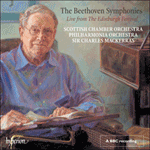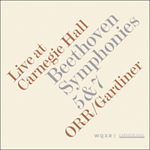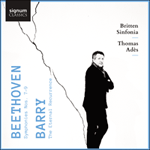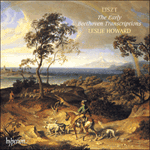
Welcome to Hyperion Records, an independent British classical label devoted to presenting high-quality recordings of music of all styles and from all periods from the twelfth century to the twenty-first.
Hyperion offers both CDs, and downloads in a number of formats. The site is also available in several languages.
Please use the dropdown buttons to set your preferred options, or use the checkbox to accept the defaults.

 PERFORMANCE
PERFORMANCE RECORDING
RECORDINGIt was during just such a period of recovery that Beethoven wrote his Seventh Symphony. In 1811, the prominent Viennese physician Dr Giovanni Malfatti recommended that Beethoven spend the summer in the Bohemian spa-town of Teplitz, famous for its ‘cure’. This was one of the very few pieces of good medical advice Beethoven ever received. Whatever the value of the spa’s famous water treatment, Teplitz was also a place of relative sanctuary in politically turbulent times. During the Napoleonic wars, diplomats from all sides would meet there for discussions, regarding it as neutral territory. The visit obviously gave Beethoven a tremendous personal and artistic boost. When he returned to Vienna in the autumn he had plans for two new symphonies. He began writing the Seventh almost immediately, while making notes about ‘a second symphony in D minor’. The latter did not fully materialise until twelve years later, as the choral Ninth; but almost as soon as Beethoven had finished No 7, in May 1812, he started work on the Eighth—the most playful and perhaps the least troubled of all his symphonies.
It is always a good idea to be careful about making direct comparisons between Beethoven’s presumed emotional state at a particular time and the character of the music he produced then. When Beethoven wrote that despairing Heiligenstadt Testament in the summer of 1802 he was also working on his Second Symphony—a work not without its dark and abrasive moments but, most commentators would agree, ultimately positive and full of vitality. Still it is hard to avoid the feeling that Beethoven’s renewed dynamism after his stay in Teplitz expressed itself directly in his Seventh Symphony—the symphony whose finale Wagner famously described as ‘the apotheosis of the dance’. The sheer physical energy of the work, expressed in bracing muscular rhythms and brilliant orchestration, can in some performances border on the unnerving. Confronted with one of the symphony’s many obsessively repeating passages (possibly the long final crescendo in the first movement), Beethoven’s younger contemporary Carl Maria von Weber pronounced him ‘ripe for the madhouse’. There are also darker, destabilising elements, chiefly expressed in the symphony’s recurring tendency to lean towards the relatively remote keys of C and F major. Yet at the end of the Seventh Symphony the home key of A major re-emerges in full splendour, reinforced by two massive cadential passages, both marked fff, fortississimo—one of the earliest examples of such an extreme dynamic in music.
At first there seems to be little of the dance about the Seventh Symphony. Slow-moving woodwind phrases are brusquely punctuated by chords from the full orchestra, but faster string figures soon galvanise the music into physical action. Eventually this substantial introductory section settles on a single note—an E, repeated softly by alternating woodwind and strings. This quickly begins to pick up energy and develops into a sprightly dotted rhythm, with which the Vivace begins. The basic dotted rhythm—basically an emphatic long note followed by two short ones (DA da-da: in poetic metrical terms, a ‘dactyl’)—not only dominates this first movement but plays a crucial part in the other three. You can also hear it (in a slightly different form) in the main theme of the following Allegretto, after the initial minor key wind chord calls us to attention. In fact the basic DA da-da rhythm is present in almost every bar of this uniquely atmospheric variation-like movement. The Allegretto was such a success at its first performance that it had to be repeated. It left a huge imprint on the young Schubert, who echoed its measured but far from earthbound tread in a number of his later works.
After the Allegretto, the Presto bursts into life. This movement has all the sprinting energy of a typical Beethoven Scherzo. It is twice interrupted by a substantial slower Trio section (with another version of the DA da-da rhythmic pattern in its main theme), and yet its vitality seems irrepressible: at the end of the movement a third, more tentative attempt to establish the slower Trio theme (major, then minor) is magnificently dismissed by five crisp orchestral chords. The Scherzo, however, ends as it began, in the ‘wrong’ key: the destabilising F major. It is now the finale’s task to ram home the symphony’s tonic key, A major. It duly begins with a massive assertion of the note E, the dominant of A major, which continues pounding emphatically in the bass almost throughout the first phase of the main theme. The movement develops into a magnificent bacchanal, driving almost to frenzy at the symphony’s seminal DA da-da pattern. The coda veers dangerously towards F for one last time; but at last the bass F falls to a far more rational E, and a huge crescendo begins. The last thing we hear is the Seventh Symphony’s basic dactylic rhythm, twice, fused triumphantly with the home triad, A major.
from notes by Stephen Johnson © 2012
Ce fut durant une telle période de convalescence que Beethoven écrivit sa Septième Symphonie. En 1811, le docteur Giovanni Malfatti, éminent médecin viennois, avait recommandé à Beethoven d’aller passer l’été dans la ville d’eaux de Teplitz, en Bohême, célèbre pour ses «cures». Ce fut l’un très rares bons avis médicaux que Beethoven reçut de toute sa vie. Indépendamment des célèbres eaux thermales et de leurs vertus, Teplitz faisait d’une certaine manière figure de refuge en ces temps de troubles politiques. Pendant les guerres napoléoniennes, les diplomates de tous horizons s’y rencontraient pour discuter, voyant en Teplitz un territoire neutre. Le séjour, manifestement, devait considérablement stimuler Beethoven, tant sur le plan personnel qu’artistique. Lorsque, à l’automne, il rentra à Vienne, il avait des projets pour deux nouvelles symphonies. Il commença d’écrire la Septième presque immédiatement, tout en prenant des notes pour «une seconde symphonie en ré mineur». Si cette dernière ne se concrétisa véritablement que douze ans plus tard—ce sera la Neuvième «avec chœur»—, à peine la Septième terminée, en mai 1812, Beethoven mit en chantier la Huitième—la plus enjouée et peut-être la moins tourmentée de toutes ses Symphonies.
Il est toujours bon de se garder de comparaisons directes entre l’état émotionnel supposé de Beethoven à un moment particulier et le caractère de la musique qu’il composa dans le même temps. Lorsque Beethoven rédigea son déchirant «Testament de Heiligenstadt», durant l’été 1802, il travaillait aussi à sa Deuxième Symphonie—une œuvre certes non dépourvue de moments sombres et caustiques mais, la plupart des commentateurs en seront d’accord, finalement positive et pleine d’énergie. Il serait néanmoins difficile de ne pas ressentir combien le dynamisme de Beethoven, revigoré par son séjour à Teplitz, s’est directement exprimé dans sa Septième Symphonie, celle dont Wagner qualifiera le finale—expression demeurée célèbre—d’«apothéose de la danse». L’énergie purement physique de l’ouvrage, qui s’exprime à travers des rythmes robustes et toniques ainsi qu’une brillante orchestration, peut dans certaines interprétations finir presque par énerver. Confronté à l’un des nombreux passages de la Symphonie obsessionnellement répétés (peut-être le long crescendo final du premier mouvement), Carl Maria von Weber, contemporain et cadet de Beethoven, le déclara «mûr pour l’asile de fous». On trouve également divers éléments plus sombres et déstabilisants, principalement traduits par cette tendance récurrente de la Symphonie à s’orienter vers les tonalités relativement éloignées d’ut et fa majeur. Cependant, à la fin de la Septième Symphonie, c’est la tonalité principale de la majeur qui de nouveau s’impose dans toute sa splendeur, renforcée par deux puissantes sections de type cadence, toutes deux indiquées fff (fortississimo)—l’un des premiers exemples d’une dynamique aussi extrême en musique.
À première vue, la danse semble n’avoir guère de place dans la Septième Symphonie. Les phrases lentes des vents sont brusquement ponctuées d’accords de l’orchestre au complet, mais des figures plus rapides aux cordes galvanisent bientôt la musique, comme physiquement poussée à l’action. Cette substantielle section d’introduction finit par reposer sur une seule note—un mi, doucement répété par les vents et les cordes en alternance. Très vite l’énergie s’en trouve décuplée, jusqu’à introduire un rythme vigoureusement pointé sur lequel le Vivace commence. Le rythme pointé de base—qui revient à une note longuement accentuée suivie de deux brèves (DA da-da, ce qu’en termes de métrique poétique on nomme un «dactyle»)ùne domine pas seulement le premier mouvement mais joue un rôle crucial dans les trois autres. On peut aussi l’entendre (sous une forme légèrement différente) dans le thème principal de l’Allegretto qui s’ensuit, après que l’accord initial des vents en tonalité mineure a capté notre attention. En fait, le rythme de base DA da-da est présent dans presque chaque mesure de ce mouvement de type variation et à l’atmosphère unique. L’Allegretto eut un tel succès lors de la première audition de l’œuvre qu’il dut être bissé. Il laissa une empreinte considérable sur le jeune Schubert, qui dans nombre de ses œuvres postérieures se fit l’écho de sa démarche mesurée mais nullement terre à terre.
Après l’Allegretto, c’est un Presto qui fait irruption. Ce mouvement a tout de l’énergie bondissante d’un scherzo typiquement beethovénien. Il est à deux reprises interrompu par une section à la fois substantielle et plus lente (Trio), dont une autre version du motif rythmique DA da-da sous-tend le thème principal, bien que d’une vitalité ne semblant pas moins irrésistible: à la fin du mouvement, une troisième tentative, plus indécise, d’imposer le thème plus lent du Trio (en majeur, puis en mineur) est magnifiquement repoussée par cinq accords cinglants de l’orchestre. Le scherzo n’en finit pas moins comme il a commencé, dans une «mauvaise» tonalité: celle, déstabilisante, de fa majeur. Ce sera dès lors la mission du finale que de réintroduire le ton de la majeur, tonalité de base de la Symphonie. Celui-ci commence, comme il convient, sur une puissante affirmation de la note mi, dominante de la majeur, qui continue, martelée à la basse, presque tout au long de la première incise du thème principal. Le mouvement se développe ensuite en une somptueuse bacchanale, menant presque jusqu’à la frénésie le motif fondateur DA da-da de la Symphonie. Une dernière fois, la coda vire dangereusement vers fa, puis ce fa glisse à la basse vers un mi sensiblement plus rationnel, avant que ne s’amorce un gigantesque crescendo. La dernière chose que l’on entend est le rythme dactylique de base de la Symphonie, par deux fois, qui triomphalement fusionne avec l’accord parfait du ton principal, la majeur.
extrait des notes rédigées par Stephen Johnson © 2012
Français: Michel Roubinet
In einer solchen Phase der Erholung schrieb Beethoven seine Siebente Symphonie. 1811 riet der prominente Wiener Arzt Dr. Giovanni Malfatti dem Komponisten, den Sommer in dem bekannten böhmischen Kurbad Teplitz zu verbringen. Das war einer der sehr wenigen guten medizinischen Ratschläge, die Beethoven jemals erhielt. Was auch immer der Wert der Therapie in den berühmten Heilquellen gewesen sein mochte, Teplitz war auch ein Ort relativer Ruhe in politisch turbulenten Zeiten; während der Napoleonischen Kriege trafen sich dort Diplomaten aller Couleur zu Diskussionen, weil sie ihn als neutrales Gelände betrachteten. Der Besuch gab Beethoven offenbar gewaltige persönliche und künstlerische Impulse. Als er im Herbst nach Wien zurückkehrte, hatte er Pläne für zwei neue Symphonien. Mit der Siebenten begann er fast sofort und machte sich gleichzeitig Notizen für „eine zweite Symphonie in d-Moll“. Letztere nahm erst zwölf Jahre später, als Chorsymphonie Nr. 9, in vollem Umfang Gestalt an; aber sobald er die Siebente beendet hatte, im Mai 1812, machte er sich gleich an die Achte—von all seinen Symphonien die spielerischste und vielleicht am wenigsten turbulente.
Es empfiehlt sich immer, bei direkten Vergleichen zwischen Beethovens mutmaßlicher seelischer Verfassung und dem Charakter seiner Musik, die er zu einer bestimmten Zeit komponierte, zurück haltend zu sein. Als Beethoven im Sommer 1802 jenes verzweifelte ‘Heiligenstädter Testament’ zu Papier brachte, arbeitete er gerade an seiner Zweiten Symphonie—einem Werk nicht ohne dunkle und harsche Momente, aber, und darin sind sich wohl die meisten Kommentatoren einig, letzten Endes positiv und voller Vitalität. Gleichwohl lässt sich der Eindruck kaum vermeiden, Beethovens neuerliche Dynamik nach seinem Aufenthalt in Teplitz sei in seiner Nr. 7 direkt zu spüren—der Symphonie, dessen Finale Wagner bekanntlich als „Apotheose des Tanzes“ bezeichnete. Die rein physische Kraft des Werkes, die in belebenden, kraftvollen Rhythmen und einer brillanten Orchestrierung zum Ausdruck kommt, kann in manchen Aufführungen nahezu unerträglich werden. Angesichts der zahlreichen obsessiven Wiederholungen in der Symphonie (vielleicht das lange Crescendo im Finale des ersten Satzes) nannte ihn sein jüngerer Zeitgenosse Carl Maria von Weber „reif fürs Irrenhaus“. Vorhanden sind auch dunklere, destabilisierende Elemente, die hauptsächlich in der fortwährenden Tendenz der Symphonie zum Ausdruck kommen, zu den relativ fernen Tonarten C-Dur und F-Dur zu streben. Doch am Ende der Siebenten taucht die Grundtonart A-Dur in vollem Glanz wieder auf, verstärkt durch zwei mächtige kadenzartige Passagen, beide mit der Vortrags bezeichnung fff, fortississimo—eines der frühesten Beispiele für eine derart extreme Dynamik in der Musik.
Auf Anhieb scheint die Siebente Symphonie nicht sehr viel Tänzerisches zu beinhalten. Langsam fließende Holzbläserphrasen werden unvermittelt von Akkorden des gesamten Orchesters inter punktiert, doch schnellere Streicherfiguren bringen die Musik bald in Aktion. Dieser wesentliche Einleitungsteil kommt schließlich auf einer einzelnen Note zur Ruhe—einem E, das von Holzbläsern und Streichern im Wechsel sachte wiederholt wird. Dieses gewinnt rasch an Energie und weitet sich aus zu einem lebhaften punktierten Rhythmus, mit dem das Vivace einsetzt. Der punktierte Grundrhythmus—im Prinzip eine betonte lange Note, der zwei kurze folgen (DA-da-da: in der Metrik ein „Daktylus“)—dominiert nicht nur diesen ersten Satz, sondern spielt auch in den drei übrigen Sätzen eine wesentliche Rolle. Er ist auch (in leicht veränderter Form) im Hauptthema des folgenden Allegrettos zu hören, nachdem der einleitende Mollakkord der Bläser unsere Aufmerksamkeit beansprucht. In der Tat ist der DA-da-da-Grundrhythmus in fast jedem Takt dieses ungemein stimmungsvollen variationsartigen Satzes vorhanden. Das Allegretto war bei seiner Uraufführung ein so großer Erfolg, dass es wiederholt werden musste. Es machte auf den jungen Schubert einen großen Eindruck, in dessen späteren Werken sich Anklänge finden an den gemessenen, doch keineswegs erdverhafteten Schritt dieses Satzes.
Nach dem Allegretto erwacht unvermittelt das Presto zum Leben. Dieser Satz weist die typische rastlose Energie eines Beethoven-Scherzos auf. Er wird zweimal von einem wesentlich langsameren Trioabschnitt unterbrochen (mit einer weiteren Variante des rhythmischen Grundmusters DA-da-da), und doch scheint seine Vitalität unbezähmbar—am Ende des Satzes wird ein dritter, zaghafterer Versuch, das langsamere Triothema (Dur, dann Moll) zu etablieren, durch fünf kernige Orchesterakkorde auf grandiose Weise abgewehrt. Das Scherzo endet jedoch, wie es begonnen hatte, in der ‘falschen’ Tonart, dem destabilisierenden F-Dur. Nun ist es die Aufgabe des Finales, die Grundtonart der Symphonie, A-Dur, klar und deutlich zum Ausdruck zu bringen. Es beginnt, wie es sich gehört, mit einem kraftvoll bestätigten Einsatz der Note E, der Dominante von A-Dur, die ihr emphatisches Hämmern im Bass fast die ganze erste Phase des Hauptthemas beibehält. Der Satz entwickelt sich zu einem prachtvollen Bacchanal und treibt das in der Symphonie angelegte Da-da-da-Grundmuster fast bis zum Wahnsinn. Die Coda schert ein letztes Mal gefährlich zum F aus, aber das Bass-F fällt schließlich auf ein sehr viel sinnvolleres E herab, und ein riesiges Crescendo beginnt. Das Letzte, was wir hören, ist der daktylische Grundrhythmus der Symphonie, der zweimal triumphal mit dem Dreiklang der Grund tonart A-dur verschmilzt.
aus dem Begleittext von Stephen Johnson © 2012
Deutsch: Gudrun Meier
 Beethoven: Symphonies Beethoven: Symphonies‘Hyperion's set is that early evening Beethoven cycle caught in recordings of remarkable intimacy and focus … it is a set I would happily put int ... ‘So magnificently exhilharating an account’ (BBC Music Magazine)» More |
 Beethoven: Symphonies Nos 2 & 7 Beethoven: Symphonies Nos 2 & 7Beethoven's muscular second symphony, completed early in 1802, is coupled with No 7 of a decade later, the finale of which was famously described by Wagner as representing ‘the apotheosis of the dance’. Performances are everything we have come to ...» More |
 Beethoven: Symphonies Nos 5 & 7 Beethoven: Symphonies Nos 5 & 7Sir John Eliot’s Gardiner’s reading of these familiar pieces highlights their revolutionary origin. Performing on period instruments, the Orchestre Révolutionnaire et Romantique brings light, clarity and brisk energy, as well as a warm and genuine ...» More |
 Beethoven: Symphonies Nos 7, 8 & 9 Beethoven: Symphonies Nos 7, 8 & 9Beethoven's final three symphonies—Nos 7 & 8 composed as a pair in 1812, the monumental No 9 following twelve years later and concluding with the famous 'Ode to Joy'. Beethoven's original audience was decidedly ambivalent regarding his use of huma ...» More |
 Liszt: Complete Piano Music Liszt: Complete Piano MusicLeslie Howard’s recordings of Liszt’s complete piano music, on 99 CDs, is one of the monumental achievements in the history of recorded music. Remarkable as much for its musicological research and scholarly rigour as for Howard’s Herculean piano p ...» More |
 Liszt: The complete music for solo piano, Vol. 44 - The Early Beethoven Transcriptions Liszt: The complete music for solo piano, Vol. 44 - The Early Beethoven Transcriptions‘One can only marvel at Leslie Howard's tireless advocacy of Liszt, and the way he constantly overcomes the multitude of technical obstacles in his pa ... ‘This early Beethoven collection finds Howard on top form. The notes which [he] writes to accompany each issue are erudite, witty, totally enthralling ...» More |

